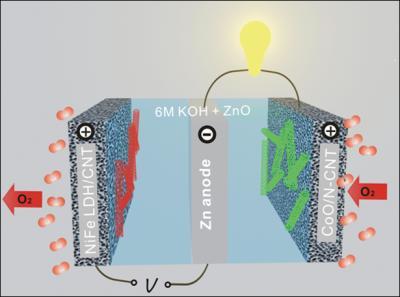Scientists develop a low-cost alternative to lithium-ion batteries
Thursday, 30 May, 2013
Stanford University scientists have developed an advanced zinc-air battery with higher catalytic activity and durability than similar batteries made with costly platinum and iridium catalysts.
The results could lead to the development of a low-cost alternative to conventional lithium-ion batteries widely used today.
“There have been increasing demands for high-performance, inexpensive and safe batteries for portable electronics, electric vehicles and other energy storage applications,” said Hongjie Dai, a professor chemistry at Stanford and lead author of the study. “Metal-air batteries offer a possible low-cost solution.”
According to Dai, most attention has focused on lithium-ion batteries, despite their limited energy density (energy stored per unit volume), high cost and safety problems. “With ample supply of oxygen from the atmosphere, metal-air batteries have drastically higher theoretical energy density than either traditional aqueous batteries or lithium-ion batteries,” he said.
“Among them, zinc-air is technically and economically the most viable option.”
Zinc-air batteries combine atmospheric oxygen and zinc metal in a liquid alkaline electrolyte to generate electricity with a by-product of zinc oxide. When the process is reversed during recharging, oxygen and zinc metal are regenerated.
“Zinc-air batteries are attractive because of the abundance and low cost of zinc metal, as well as the non-flammable nature of aqueous electrolytes, which make the batteries inherently safe to operate,” Dai said.

“Primary (non-rechargeable) zinc-air batteries have been commercialised for medical and telecommunication applications with limited power density. However, it remains a grand challenge to develop electrically rechargeable batteries, with the stumbling blocks being the lack of efficient and robust air catalysts, as well as the limited cycle life of the zinc electrodes.”
Active and durable electrocatalysts on the air electrode are required to catalyse the oxygen-reduction reaction during discharge and the oxygen-evolution reaction during recharge. In zinc-air batteries, both catalytic reactions are sluggish, Dai said.
Recently, his group has developed a number of high-performance electrocatalysts made with non-precious metal oxide or nanocrystals hybridised with carbon nanotubes. These catalysts produced higher catalytic activity and durability in alkaline electrolytes than catalysts made with platinum and other precious metals.
“We found that similar catalysts greatly boosted the performance of zinc-air batteries,” Dai said.
“A combination of a cobalt-oxide hybrid air catalyst for oxygen reduction and a nickel-iron hydroxide hybrid air catalyst for oxygen evolution resulted in a record high-energy efficiency for a zinc-air battery, with a high specific energy density more than twice that of lithium-ion technology.”
The novel battery also demonstrated good reversibility and stability over long charge and discharge cycles over several weeks. “This work could be an important step toward developing practical rechargeable zinc-air batteries, even though other challenges relating to the zinc electrode and electrolyte remain to be solved,” Dai added.
The results of this study were published in the 7 May online edition of the journal Nature Communications. Other authors of the study are Yanguang Li (lead author), Ming Gong, Yongye Liang, Ju Feng, Ji-Eun Kim, Hailiang Wang, Guosong Hong and Bo Zhang of the Stanford Department of Chemistry. The study was supported by Intel, a Stanford Global Climate and Energy Project exploratory program and a Stinehart/Reed Award from the Stanford Precourt Institute for Energy.
Creating the truck of tomorrow
Exploring the technological innovations, infrastructure solutions and emerging delivery methods...
Aussie researchers claim efficiency record for solar cells
Researchers from the University of Sydney have achieved 27.06% efficiency with a new...
Atom-thick filter boosts lithium–sulfur battery life
Researchers have developed a graphene-based filter that blocks sulfur chains in...






